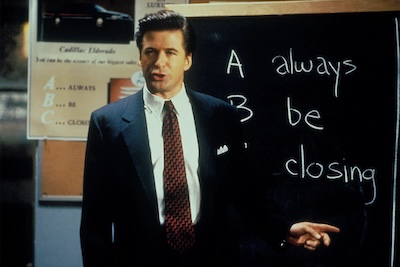A precocious young girl sets out in the morning light to sell some wooden carvings that her father made, but she doesn’t know that her life will forever when the day draws to a close. Set in South Africa, Cindy Lee’s The Last Ranger feels a world away, but she brings immediacy and danger to this coming-of-age tale. Before our very eyes, we see how violence can play out in this young girl’s backyard, and we witness her growing up before our very eyes.
**This interview contains some spoilers for The Last Ranger.**
Litha is excited to try to sell her father’s carvings of the native rhinos but Khusi, a ranger determined to protect these animals from poachers, explains that COVID will probably keep tourists away for many more moths. This young girl lives with her father and her grandmother, and her mother has passed away. Khusi, on the other hand, seems like a person who finds strength in working alone, but Shaw, a co-writer along with David S. Lee and Will Hawkes, explains some of the backstory he wanted to infuse into the script’s DNA.
“It’s very common for female rangers to have gone to work a long way from home and they have left their families,” Shaw says. “Some of them have been victims of abuse, and they find a way to support themselves. Originally, the story was about a father and son, and when we decided to change the genders, we thought it explored something that you don’t often see represented in the world of a surrofgate mother. We thought that it would add a beautiful element to this woman who has taken on these animals as a surrogate family and is closed off to Litha at first. There’s a certain gruffness and reticence to step forward, and then it would really be able to show us the development of this bond and how she starts to melt because of the purity and love coming from this little girl.”
You sense a familiarity between these two characters even if it’s obvious that they haven’t spent a lot of time together. Khusi brings Litha to see the rhinos up close and personal, and we see Khusi witnessing Litha’s wonder. It’s a very specific kind of admiration.
“This is Liyabona [Mroqoza]’s first role,” Lee confirms. We took a hell of a chance with her, but she was way better than anything we’d ever seen. South Africa doesn’t have the biggest pool of actors to start with, and the film was very specific. We were looking for an 11 year old girl who can speak easy Xhosa and our pool was very small, so when we found her, we were very grateful. The bond that was created between her and Avumile [Qongqo] was really unbelievable to me, so I wanted to allow that to blossom. I spoke to them about backstory and how I felt that Khusi probably had a child which she’d lost. Early in the film, Khusi tells Rob to enjoy the time that he has with them, so that was really important that we created that sense of longing from her so you understand why she’s so attached to the rhino. She feels like a mother and her instincts kick in, and it happens the same when between her and Litha.”
 “Oftentimes you see a strong father-son story driven through international cinema,” Shaw says. “In our film, these women are both keepers of the flame. There is an incredibler moment where Litha becomes mother herself. When they meet on the road, it’s this Damascus moment where her life is now going to be incredibly changed, and there is a lot fed through it about the role of protection and our roles as people in terms of the environment in the world.”
“Oftentimes you see a strong father-son story driven through international cinema,” Shaw says. “In our film, these women are both keepers of the flame. There is an incredibler moment where Litha becomes mother herself. When they meet on the road, it’s this Damascus moment where her life is now going to be incredibly changed, and there is a lot fed through it about the role of protection and our roles as people in terms of the environment in the world.”
The Last Ranger uses no puppets or visual effects–these majestic animals were captured in the moment. There’s nothing else like it in the Live Action Short Film race. Lee even admits that she has never been this close to one of these rhinos before. The film really presents that astonishing quality before the drama explodes on screen.
“There were two sides of the coin to shooting during COVID,” Lee explains. “One was that we might lose half a day because there was a health scare, but why it really worked for us is because the actual game reserves were closed down to tourists. We were able to take over those places for two full days for the shooting days. Dr. William Fold, who actually saved Thandi’s life, was there with us the whole time. They have to dart the rhinos for other reasons and not specifically for our film–it’s very important to stress that we never darted any animal just to film them. We had two different rhinos, and we had to track them. It was difficult to get out of a follow vehicle and try to quickly set things up without scaring them. It was important to me that we get a couple of shots with all of them in the same frame, so that we know we’re not cheating this because there are different cutaways. Having them all in the same frame was something that we really wanted.
I go to reserves twice a year, but I’ve never touched one of these rhinos. I’ve never been that close to one where it’s on the ground. After the rhino was darted, they had to do about ten minutes of medical procedures, so then we only had about ten or maybe twelve minutes to shoot. Shooting those scenes was very emotional for everyone on set, including the vet, since this was the same location with the same rhino.”
When poachers close in, Lee balances the tension beautifully by switching our perspective. Because we bounce from Litha hiding in the car to Rob trying to catch up and assist to Khusi on the run with a rifle in hand, we are moved from place to place with barely any time to catch our breath.
“The race against the close was important to us,” Lee explains. “We really think that it’s going to be okay and Khusi’s going to stop it. We really want you to believe that. Once you realize that may not be the case, the time starts to tick by faster. We needed the father’s lens specifically to tie it all together because of the of the biggest parts for us in shooting this was the location and where everything was. Nothing was really close to each other. The den is in one area and the car with Litha is in another. Because the poacher had a bird’s eye view of everything, it was important that he was able to tie it all together to make us wonder if the tragedy is going to go even further. Are they going to kill a kid? Is Litha going to be able to stop a grown man? The faster the pace is, the less time you have to think about it. For Litha, it’s important for her to not have tyime to think–she goes straight into it. All of us are up against the clock.”
“Trying to piece that together was very challenging,” Shaw adds. “Putting a gun battle in the middle of a short film could definitely sink the story. When we had our first cut and we got a temp score, we showed it to John Powell. All of these perspectives tied things up, and you’ve got to establish that the father can’t see his daughter. You’ve got to build that tension.”
After the poacher has escaped with his trophy, Litha confronts her father in an impressively emotional exchange. Lee gives her young lead character the space to feel her honest, brutal emotions, and this is not how Litha imagined she would ever see her father. A child should not feel that amount of immense pain. He tells her, ‘I’ll make it better. I promise.’ Is it too late for that relationship to be repaired?
“He’s been part of it,” Shaw says, after a moment. “I think the reality is that he would probably go to jail. We had an early cut where the poacher who steals the horn runs across the dry riverbed and just gets to the edge and you suddenly see him go down. We decided that felt too wrapped up. The reality is that these people get away, and it is a crime. Litha forgives her father in the moment.”
“When she tells her father that she wants to go see Thandi, she could’ve walked away from in in that moment,” Lee says. “She didn’t need him with her in that moment, but him saying that he will make it right means that he will go to jail and do his time. That’s the thinking. Litha can grow up and look after these animals, so we were hoping to end this story on a positive note–even when we are showing you the ugly statistics of how rhinos are attacked. There is space for change.”









